UWTSD Data Centre Technologies: Design, Analysis, and Recommendations
VerifiedAdded on 2022/12/30
|18
|5123
|45
Report
AI Summary
This report provides a comprehensive overview of data center technologies, focusing on the design and implementation of an active-active architecture, particularly for UWTSD. It delves into various aspects, including the overview of data centers, different types such as colocation, enterprise, and hyperscale facilities, and the specific technical requirements for active-active designs. The report explores crucial considerations like transport technologies, network services, L4-L7 services, storage services, server virtualization, and application deployment. It also highlights critical points such as load balancing, security, management, RPO & RTO, and offers future recommendations for data center development. The analysis covers design considerations, technical requirements, and potential solutions to ensure optimal uptime, scalability, and security for UWTSD's IT infrastructure. The report emphasizes the importance of fault tolerance, consistent policy management, and the optimization of resources across data centers.
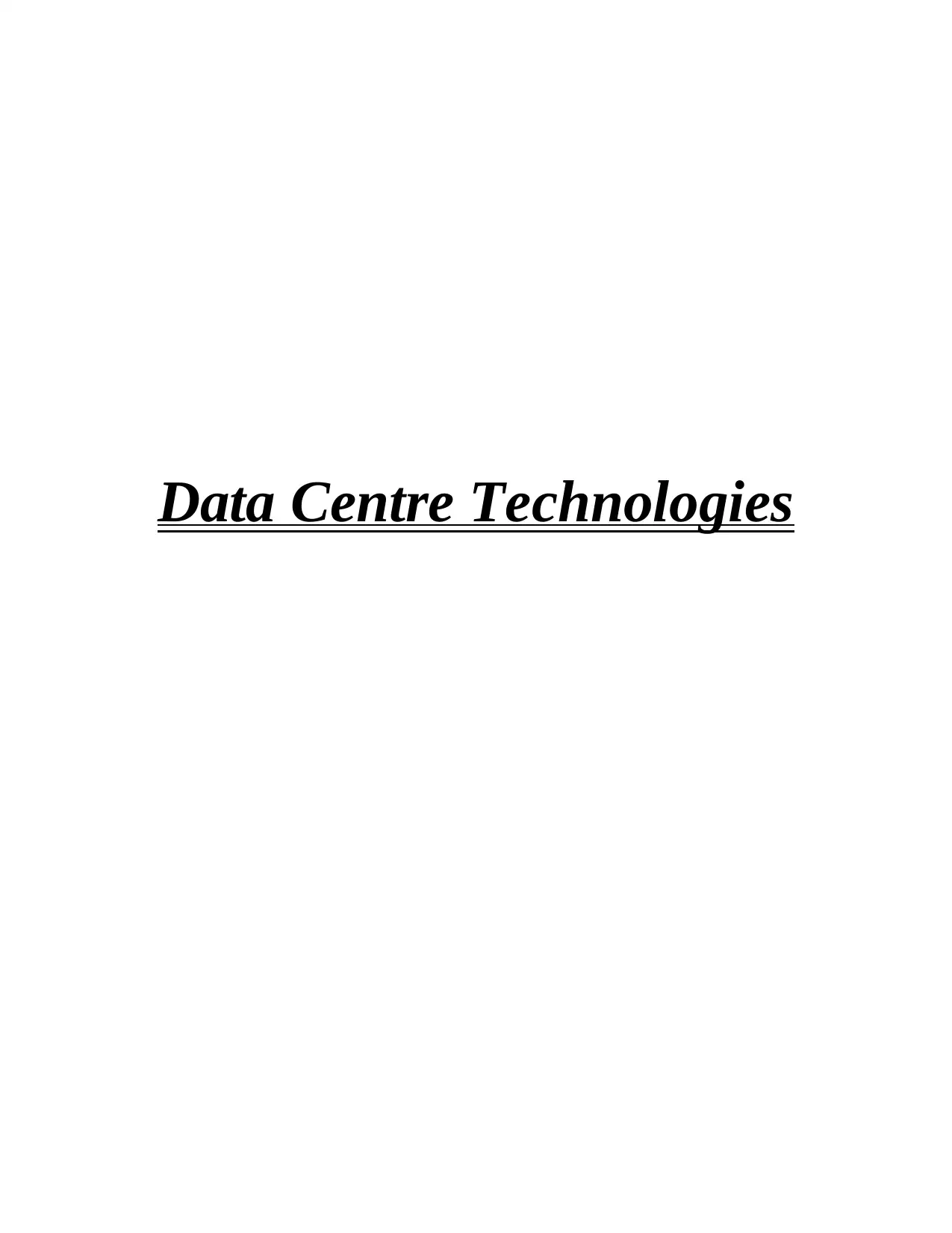
Data Centre Technologies
Paraphrase This Document
Need a fresh take? Get an instant paraphrase of this document with our AI Paraphraser
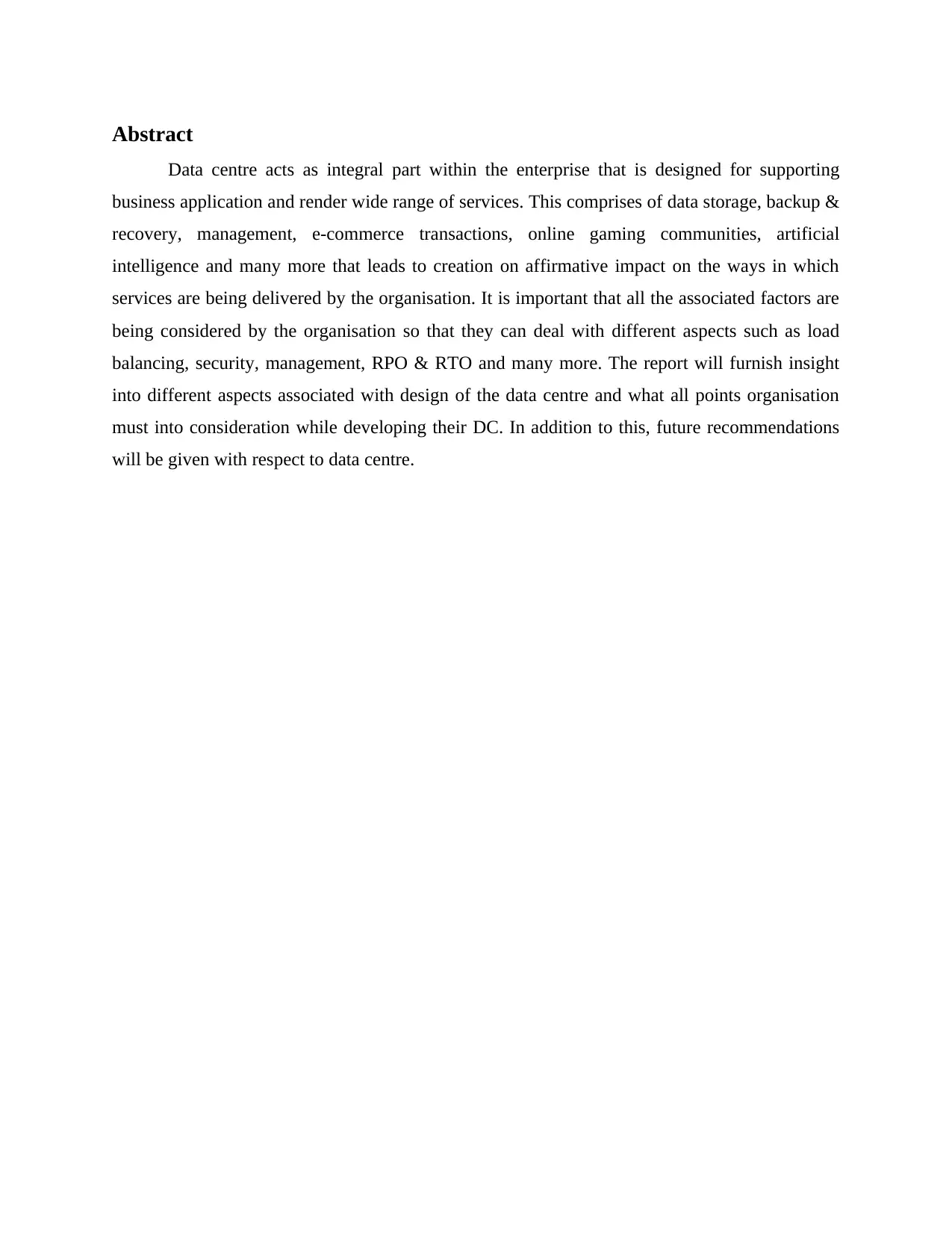
Abstract
Data centre acts as integral part within the enterprise that is designed for supporting
business application and render wide range of services. This comprises of data storage, backup &
recovery, management, e-commerce transactions, online gaming communities, artificial
intelligence and many more that leads to creation on affirmative impact on the ways in which
services are being delivered by the organisation. It is important that all the associated factors are
being considered by the organisation so that they can deal with different aspects such as load
balancing, security, management, RPO & RTO and many more. The report will furnish insight
into different aspects associated with design of the data centre and what all points organisation
must into consideration while developing their DC. In addition to this, future recommendations
will be given with respect to data centre.
Data centre acts as integral part within the enterprise that is designed for supporting
business application and render wide range of services. This comprises of data storage, backup &
recovery, management, e-commerce transactions, online gaming communities, artificial
intelligence and many more that leads to creation on affirmative impact on the ways in which
services are being delivered by the organisation. It is important that all the associated factors are
being considered by the organisation so that they can deal with different aspects such as load
balancing, security, management, RPO & RTO and many more. The report will furnish insight
into different aspects associated with design of the data centre and what all points organisation
must into consideration while developing their DC. In addition to this, future recommendations
will be given with respect to data centre.
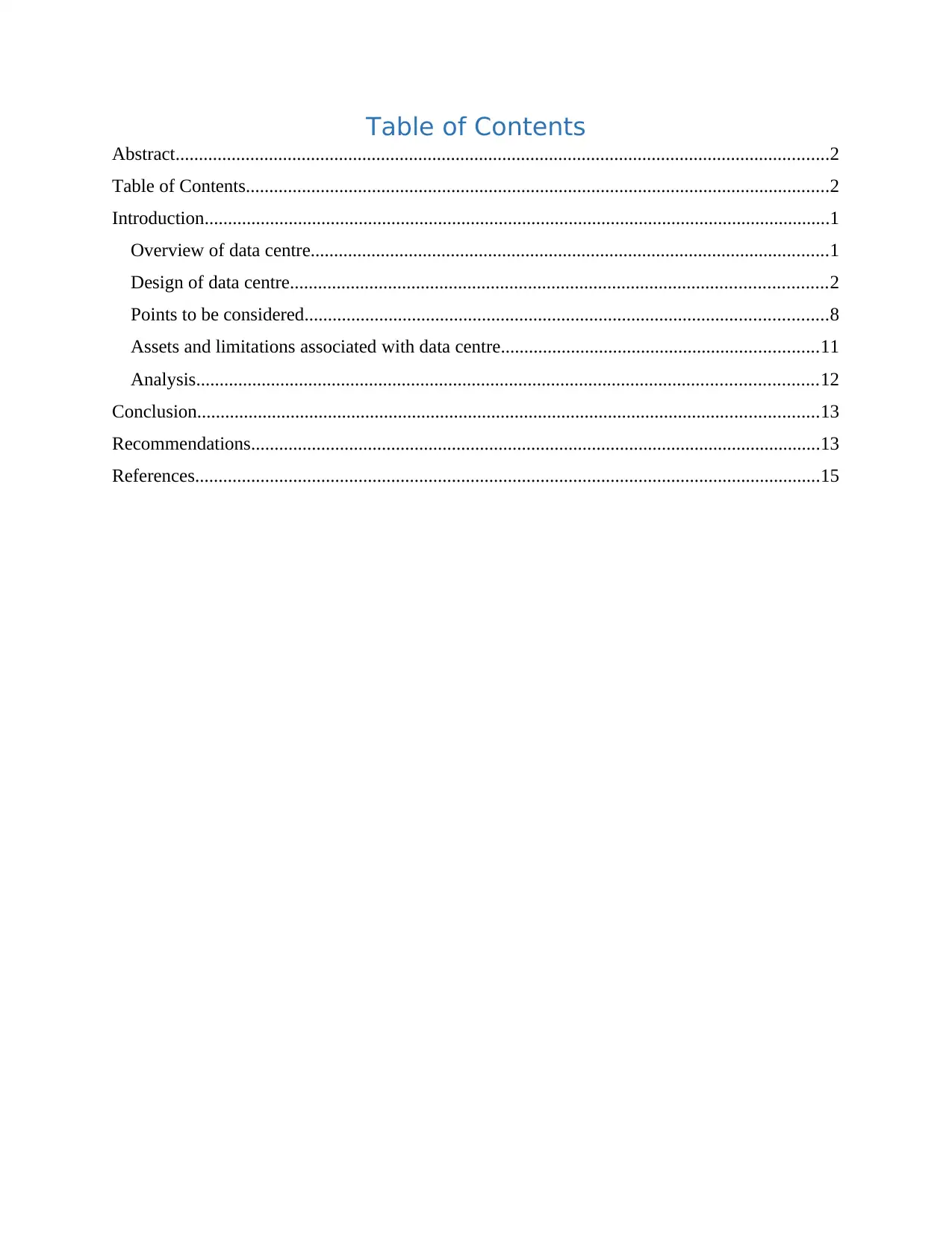
Table of Contents
Abstract............................................................................................................................................2
Table of Contents.............................................................................................................................2
Introduction......................................................................................................................................1
Overview of data centre...............................................................................................................1
Design of data centre...................................................................................................................2
Points to be considered................................................................................................................8
Assets and limitations associated with data centre....................................................................11
Analysis.....................................................................................................................................12
Conclusion.....................................................................................................................................13
Recommendations..........................................................................................................................13
References......................................................................................................................................15
Abstract............................................................................................................................................2
Table of Contents.............................................................................................................................2
Introduction......................................................................................................................................1
Overview of data centre...............................................................................................................1
Design of data centre...................................................................................................................2
Points to be considered................................................................................................................8
Assets and limitations associated with data centre....................................................................11
Analysis.....................................................................................................................................12
Conclusion.....................................................................................................................................13
Recommendations..........................................................................................................................13
References......................................................................................................................................15
⊘ This is a preview!⊘
Do you want full access?
Subscribe today to unlock all pages.

Trusted by 1+ million students worldwide

Paraphrase This Document
Need a fresh take? Get an instant paraphrase of this document with our AI Paraphraser
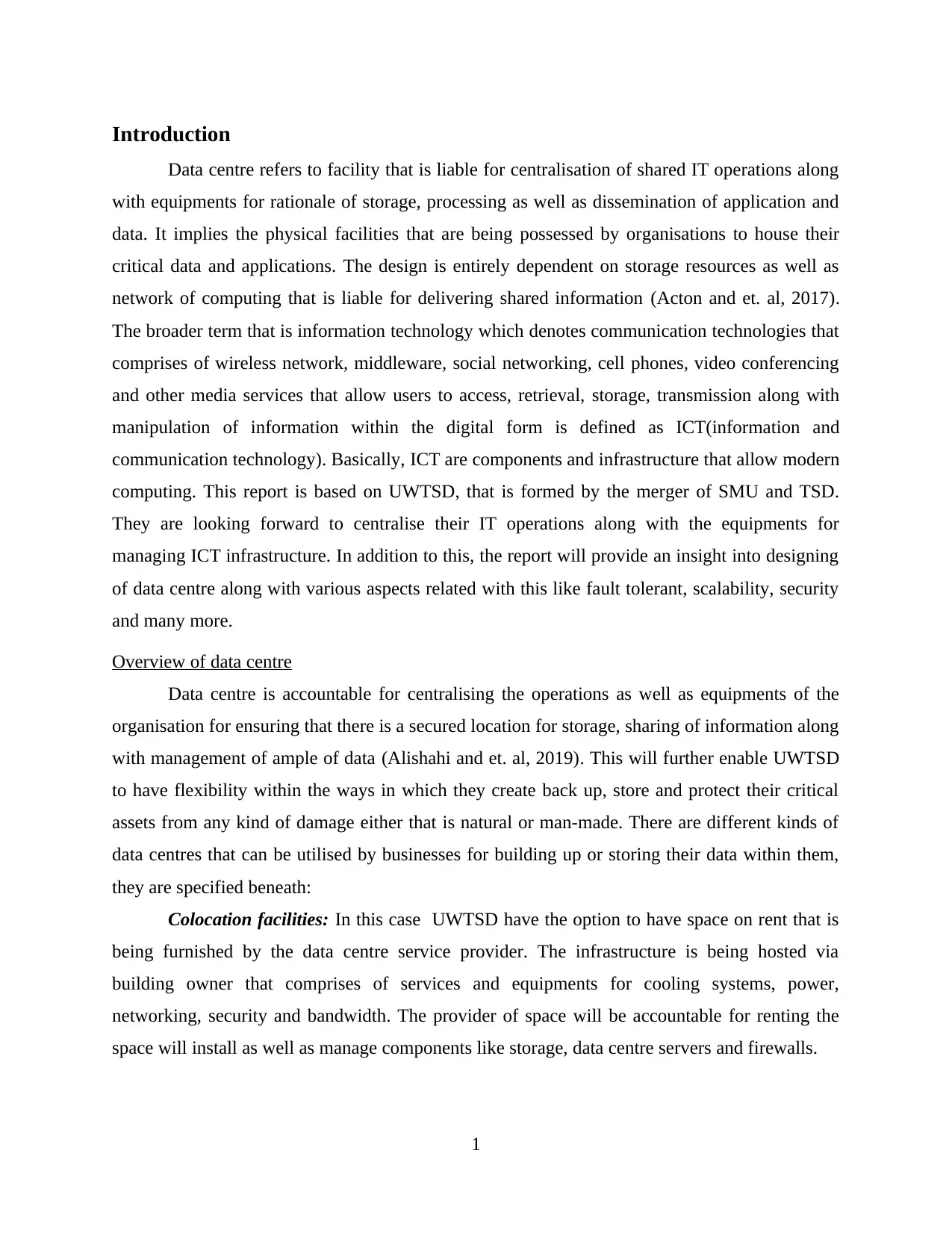
Introduction
Data centre refers to facility that is liable for centralisation of shared IT operations along
with equipments for rationale of storage, processing as well as dissemination of application and
data. It implies the physical facilities that are being possessed by organisations to house their
critical data and applications. The design is entirely dependent on storage resources as well as
network of computing that is liable for delivering shared information (Acton and et. al, 2017).
The broader term that is information technology which denotes communication technologies that
comprises of wireless network, middleware, social networking, cell phones, video conferencing
and other media services that allow users to access, retrieval, storage, transmission along with
manipulation of information within the digital form is defined as ICT(information and
communication technology). Basically, ICT are components and infrastructure that allow modern
computing. This report is based on UWTSD, that is formed by the merger of SMU and TSD.
They are looking forward to centralise their IT operations along with the equipments for
managing ICT infrastructure. In addition to this, the report will provide an insight into designing
of data centre along with various aspects related with this like fault tolerant, scalability, security
and many more.
Overview of data centre
Data centre is accountable for centralising the operations as well as equipments of the
organisation for ensuring that there is a secured location for storage, sharing of information along
with management of ample of data (Alishahi and et. al, 2019). This will further enable UWTSD
to have flexibility within the ways in which they create back up, store and protect their critical
assets from any kind of damage either that is natural or man-made. There are different kinds of
data centres that can be utilised by businesses for building up or storing their data within them,
they are specified beneath:
Colocation facilities: In this case UWTSD have the option to have space on rent that is
being furnished by the data centre service provider. The infrastructure is being hosted via
building owner that comprises of services and equipments for cooling systems, power,
networking, security and bandwidth. The provider of space will be accountable for renting the
space will install as well as manage components like storage, data centre servers and firewalls.
1
Data centre refers to facility that is liable for centralisation of shared IT operations along
with equipments for rationale of storage, processing as well as dissemination of application and
data. It implies the physical facilities that are being possessed by organisations to house their
critical data and applications. The design is entirely dependent on storage resources as well as
network of computing that is liable for delivering shared information (Acton and et. al, 2017).
The broader term that is information technology which denotes communication technologies that
comprises of wireless network, middleware, social networking, cell phones, video conferencing
and other media services that allow users to access, retrieval, storage, transmission along with
manipulation of information within the digital form is defined as ICT(information and
communication technology). Basically, ICT are components and infrastructure that allow modern
computing. This report is based on UWTSD, that is formed by the merger of SMU and TSD.
They are looking forward to centralise their IT operations along with the equipments for
managing ICT infrastructure. In addition to this, the report will provide an insight into designing
of data centre along with various aspects related with this like fault tolerant, scalability, security
and many more.
Overview of data centre
Data centre is accountable for centralising the operations as well as equipments of the
organisation for ensuring that there is a secured location for storage, sharing of information along
with management of ample of data (Alishahi and et. al, 2019). This will further enable UWTSD
to have flexibility within the ways in which they create back up, store and protect their critical
assets from any kind of damage either that is natural or man-made. There are different kinds of
data centres that can be utilised by businesses for building up or storing their data within them,
they are specified beneath:
Colocation facilities: In this case UWTSD have the option to have space on rent that is
being furnished by the data centre service provider. The infrastructure is being hosted via
building owner that comprises of services and equipments for cooling systems, power,
networking, security and bandwidth. The provider of space will be accountable for renting the
space will install as well as manage components like storage, data centre servers and firewalls.
1
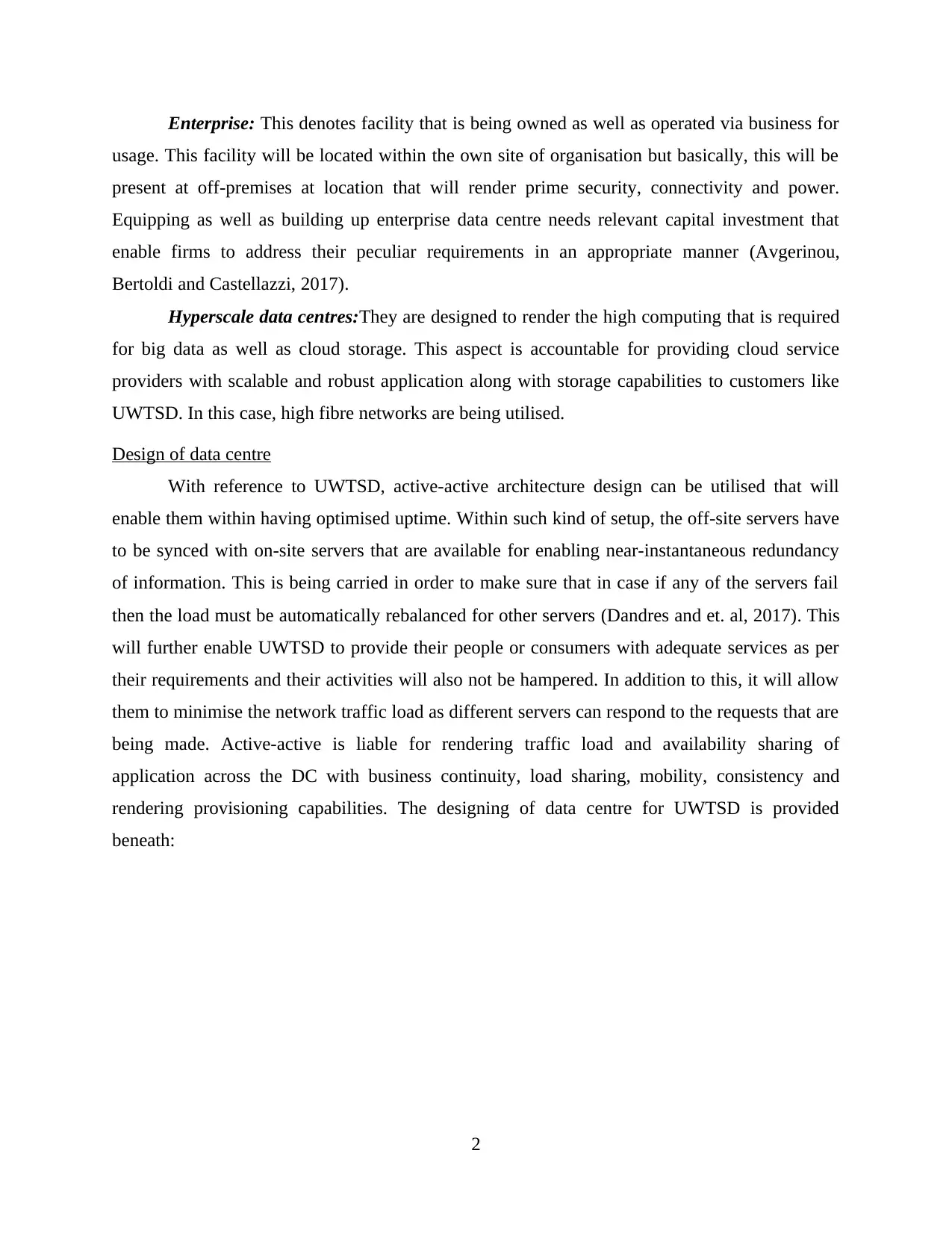
Enterprise: This denotes facility that is being owned as well as operated via business for
usage. This facility will be located within the own site of organisation but basically, this will be
present at off-premises at location that will render prime security, connectivity and power.
Equipping as well as building up enterprise data centre needs relevant capital investment that
enable firms to address their peculiar requirements in an appropriate manner (Avgerinou,
Bertoldi and Castellazzi, 2017).
Hyperscale data centres:They are designed to render the high computing that is required
for big data as well as cloud storage. This aspect is accountable for providing cloud service
providers with scalable and robust application along with storage capabilities to customers like
UWTSD. In this case, high fibre networks are being utilised.
Design of data centre
With reference to UWTSD, active-active architecture design can be utilised that will
enable them within having optimised uptime. Within such kind of setup, the off-site servers have
to be synced with on-site servers that are available for enabling near-instantaneous redundancy
of information. This is being carried in order to make sure that in case if any of the servers fail
then the load must be automatically rebalanced for other servers (Dandres and et. al, 2017). This
will further enable UWTSD to provide their people or consumers with adequate services as per
their requirements and their activities will also not be hampered. In addition to this, it will allow
them to minimise the network traffic load as different servers can respond to the requests that are
being made. Active-active is liable for rendering traffic load and availability sharing of
application across the DC with business continuity, load sharing, mobility, consistency and
rendering provisioning capabilities. The designing of data centre for UWTSD is provided
beneath:
2
usage. This facility will be located within the own site of organisation but basically, this will be
present at off-premises at location that will render prime security, connectivity and power.
Equipping as well as building up enterprise data centre needs relevant capital investment that
enable firms to address their peculiar requirements in an appropriate manner (Avgerinou,
Bertoldi and Castellazzi, 2017).
Hyperscale data centres:They are designed to render the high computing that is required
for big data as well as cloud storage. This aspect is accountable for providing cloud service
providers with scalable and robust application along with storage capabilities to customers like
UWTSD. In this case, high fibre networks are being utilised.
Design of data centre
With reference to UWTSD, active-active architecture design can be utilised that will
enable them within having optimised uptime. Within such kind of setup, the off-site servers have
to be synced with on-site servers that are available for enabling near-instantaneous redundancy
of information. This is being carried in order to make sure that in case if any of the servers fail
then the load must be automatically rebalanced for other servers (Dandres and et. al, 2017). This
will further enable UWTSD to provide their people or consumers with adequate services as per
their requirements and their activities will also not be hampered. In addition to this, it will allow
them to minimise the network traffic load as different servers can respond to the requests that are
being made. Active-active is liable for rendering traffic load and availability sharing of
application across the DC with business continuity, load sharing, mobility, consistency and
rendering provisioning capabilities. The designing of data centre for UWTSD is provided
beneath:
2
⊘ This is a preview!⊘
Do you want full access?
Subscribe today to unlock all pages.

Trusted by 1+ million students worldwide
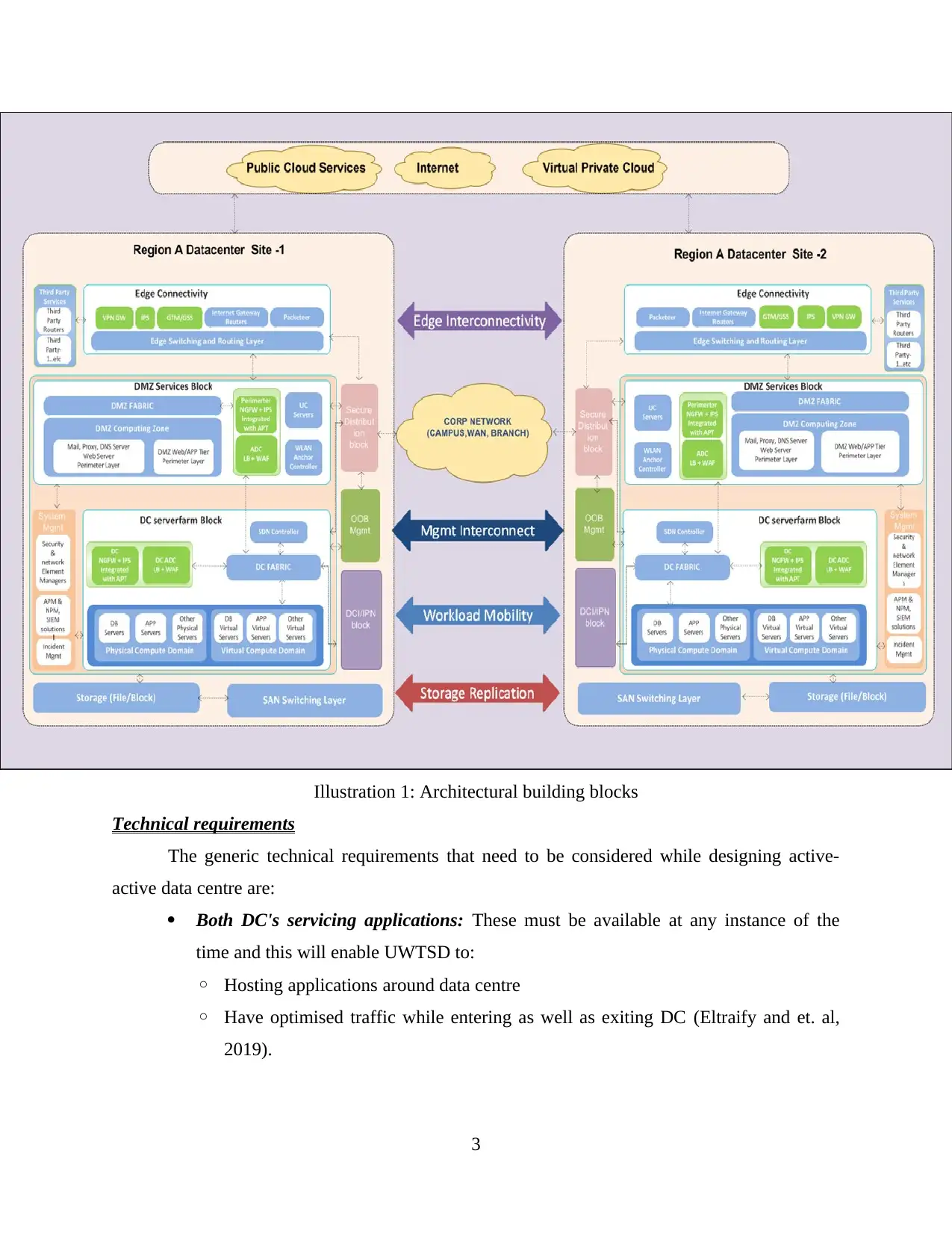
Technical requirements
The generic technical requirements that need to be considered while designing active-
active data centre are:
Both DC's servicing applications: These must be available at any instance of the
time and this will enable UWTSD to:
◦ Hosting applications around data centre
◦ Have optimised traffic while entering as well as exiting DC (Eltraify and et. al,
2019).
3
Illustration 1: Architectural building blocks
The generic technical requirements that need to be considered while designing active-
active data centre are:
Both DC's servicing applications: These must be available at any instance of the
time and this will enable UWTSD to:
◦ Hosting applications around data centre
◦ Have optimised traffic while entering as well as exiting DC (Eltraify and et. al,
2019).
3
Illustration 1: Architectural building blocks
Paraphrase This Document
Need a fresh take? Get an instant paraphrase of this document with our AI Paraphraser
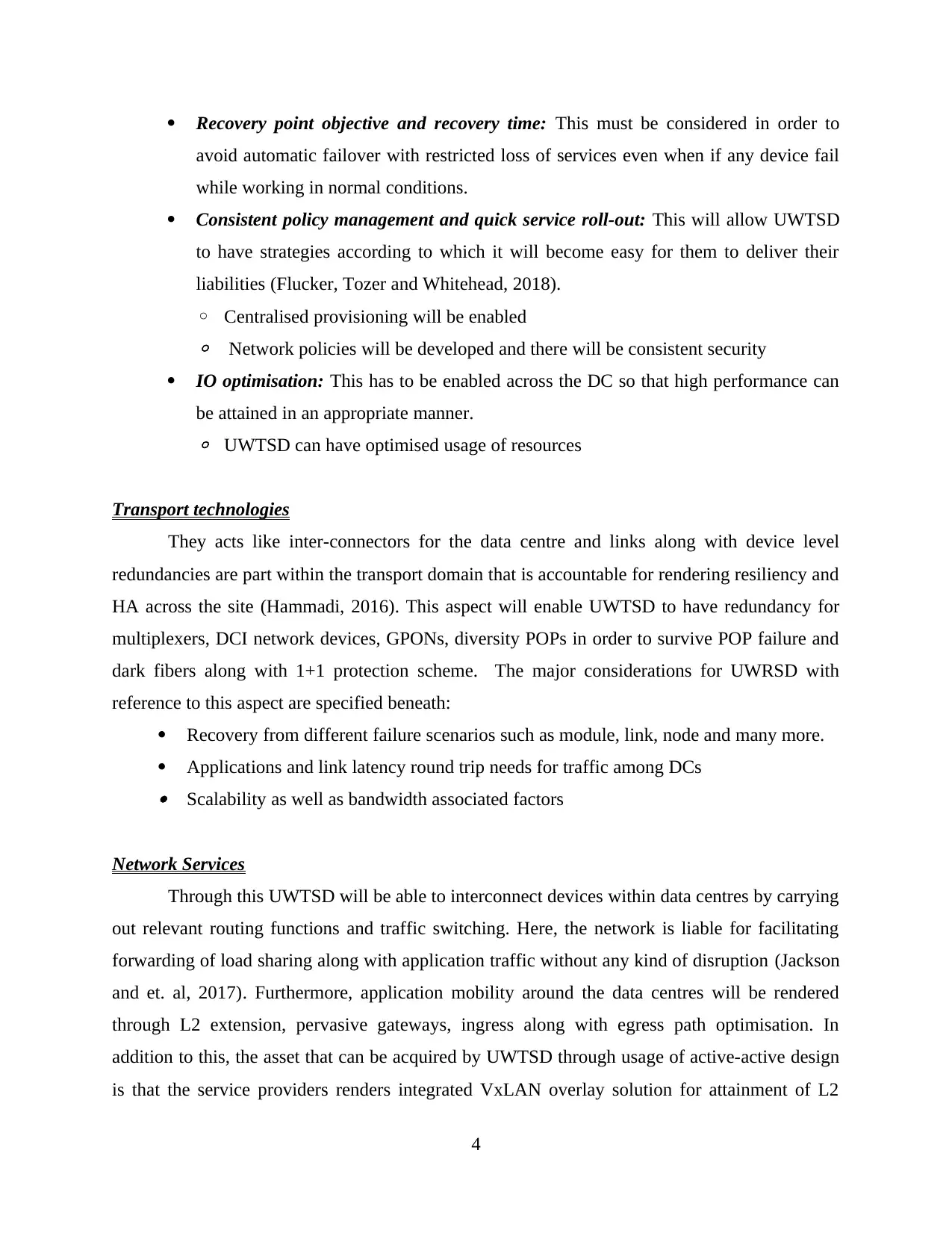
Recovery point objective and recovery time: This must be considered in order to
avoid automatic failover with restricted loss of services even when if any device fail
while working in normal conditions.
Consistent policy management and quick service roll-out: This will allow UWTSD
to have strategies according to which it will become easy for them to deliver their
liabilities (Flucker, Tozer and Whitehead, 2018).
◦ Centralised provisioning will be enabled
◦ Network policies will be developed and there will be consistent security
IO optimisation: This has to be enabled across the DC so that high performance can
be attained in an appropriate manner.
◦ UWTSD can have optimised usage of resources
Transport technologies
They acts like inter-connectors for the data centre and links along with device level
redundancies are part within the transport domain that is accountable for rendering resiliency and
HA across the site (Hammadi, 2016). This aspect will enable UWTSD to have redundancy for
multiplexers, DCI network devices, GPONs, diversity POPs in order to survive POP failure and
dark fibers along with 1+1 protection scheme. The major considerations for UWRSD with
reference to this aspect are specified beneath:
Recovery from different failure scenarios such as module, link, node and many more.
Applications and link latency round trip needs for traffic among DCs
Scalability as well as bandwidth associated factors
Network Services
Through this UWTSD will be able to interconnect devices within data centres by carrying
out relevant routing functions and traffic switching. Here, the network is liable for facilitating
forwarding of load sharing along with application traffic without any kind of disruption (Jackson
and et. al, 2017). Furthermore, application mobility around the data centres will be rendered
through L2 extension, pervasive gateways, ingress along with egress path optimisation. In
addition to this, the asset that can be acquired by UWTSD through usage of active-active design
is that the service providers renders integrated VxLAN overlay solution for attainment of L2
4
avoid automatic failover with restricted loss of services even when if any device fail
while working in normal conditions.
Consistent policy management and quick service roll-out: This will allow UWTSD
to have strategies according to which it will become easy for them to deliver their
liabilities (Flucker, Tozer and Whitehead, 2018).
◦ Centralised provisioning will be enabled
◦ Network policies will be developed and there will be consistent security
IO optimisation: This has to be enabled across the DC so that high performance can
be attained in an appropriate manner.
◦ UWTSD can have optimised usage of resources
Transport technologies
They acts like inter-connectors for the data centre and links along with device level
redundancies are part within the transport domain that is accountable for rendering resiliency and
HA across the site (Hammadi, 2016). This aspect will enable UWTSD to have redundancy for
multiplexers, DCI network devices, GPONs, diversity POPs in order to survive POP failure and
dark fibers along with 1+1 protection scheme. The major considerations for UWRSD with
reference to this aspect are specified beneath:
Recovery from different failure scenarios such as module, link, node and many more.
Applications and link latency round trip needs for traffic among DCs
Scalability as well as bandwidth associated factors
Network Services
Through this UWTSD will be able to interconnect devices within data centres by carrying
out relevant routing functions and traffic switching. Here, the network is liable for facilitating
forwarding of load sharing along with application traffic without any kind of disruption (Jackson
and et. al, 2017). Furthermore, application mobility around the data centres will be rendered
through L2 extension, pervasive gateways, ingress along with egress path optimisation. In
addition to this, the asset that can be acquired by UWTSD through usage of active-active design
is that the service providers renders integrated VxLAN overlay solution for attainment of L2
4
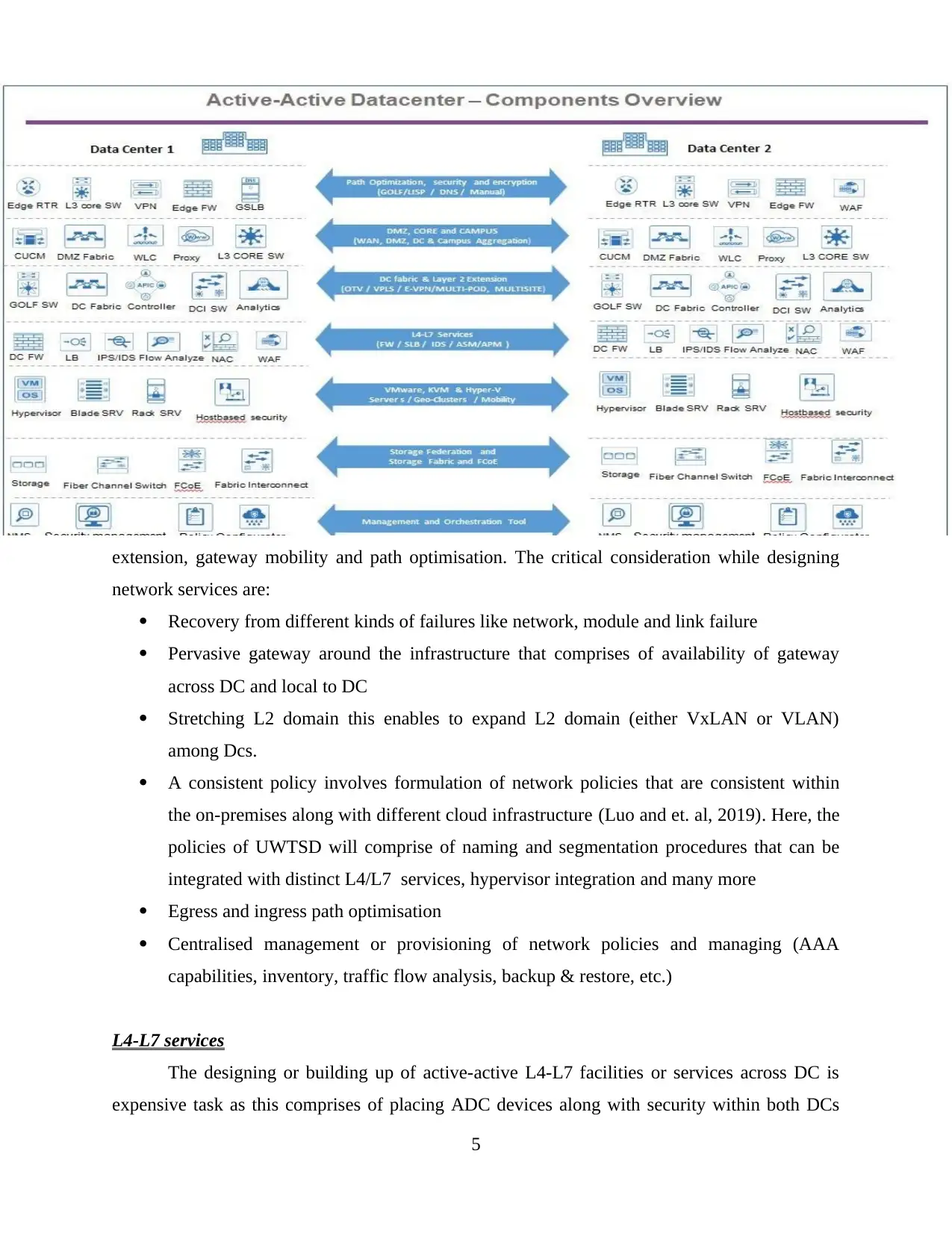
extension, gateway mobility and path optimisation. The critical consideration while designing
network services are:
Recovery from different kinds of failures like network, module and link failure
Pervasive gateway around the infrastructure that comprises of availability of gateway
across DC and local to DC
Stretching L2 domain this enables to expand L2 domain (either VxLAN or VLAN)
among Dcs.
A consistent policy involves formulation of network policies that are consistent within
the on-premises along with different cloud infrastructure (Luo and et. al, 2019). Here, the
policies of UWTSD will comprise of naming and segmentation procedures that can be
integrated with distinct L4/L7 services, hypervisor integration and many more
Egress and ingress path optimisation
Centralised management or provisioning of network policies and managing (AAA
capabilities, inventory, traffic flow analysis, backup & restore, etc.)
L4-L7 services
The designing or building up of active-active L4-L7 facilities or services across DC is
expensive task as this comprises of placing ADC devices along with security within both DCs
5
network services are:
Recovery from different kinds of failures like network, module and link failure
Pervasive gateway around the infrastructure that comprises of availability of gateway
across DC and local to DC
Stretching L2 domain this enables to expand L2 domain (either VxLAN or VLAN)
among Dcs.
A consistent policy involves formulation of network policies that are consistent within
the on-premises along with different cloud infrastructure (Luo and et. al, 2019). Here, the
policies of UWTSD will comprise of naming and segmentation procedures that can be
integrated with distinct L4/L7 services, hypervisor integration and many more
Egress and ingress path optimisation
Centralised management or provisioning of network policies and managing (AAA
capabilities, inventory, traffic flow analysis, backup & restore, etc.)
L4-L7 services
The designing or building up of active-active L4-L7 facilities or services across DC is
expensive task as this comprises of placing ADC devices along with security within both DCs
5
⊘ This is a preview!⊘
Do you want full access?
Subscribe today to unlock all pages.

Trusted by 1+ million students worldwide
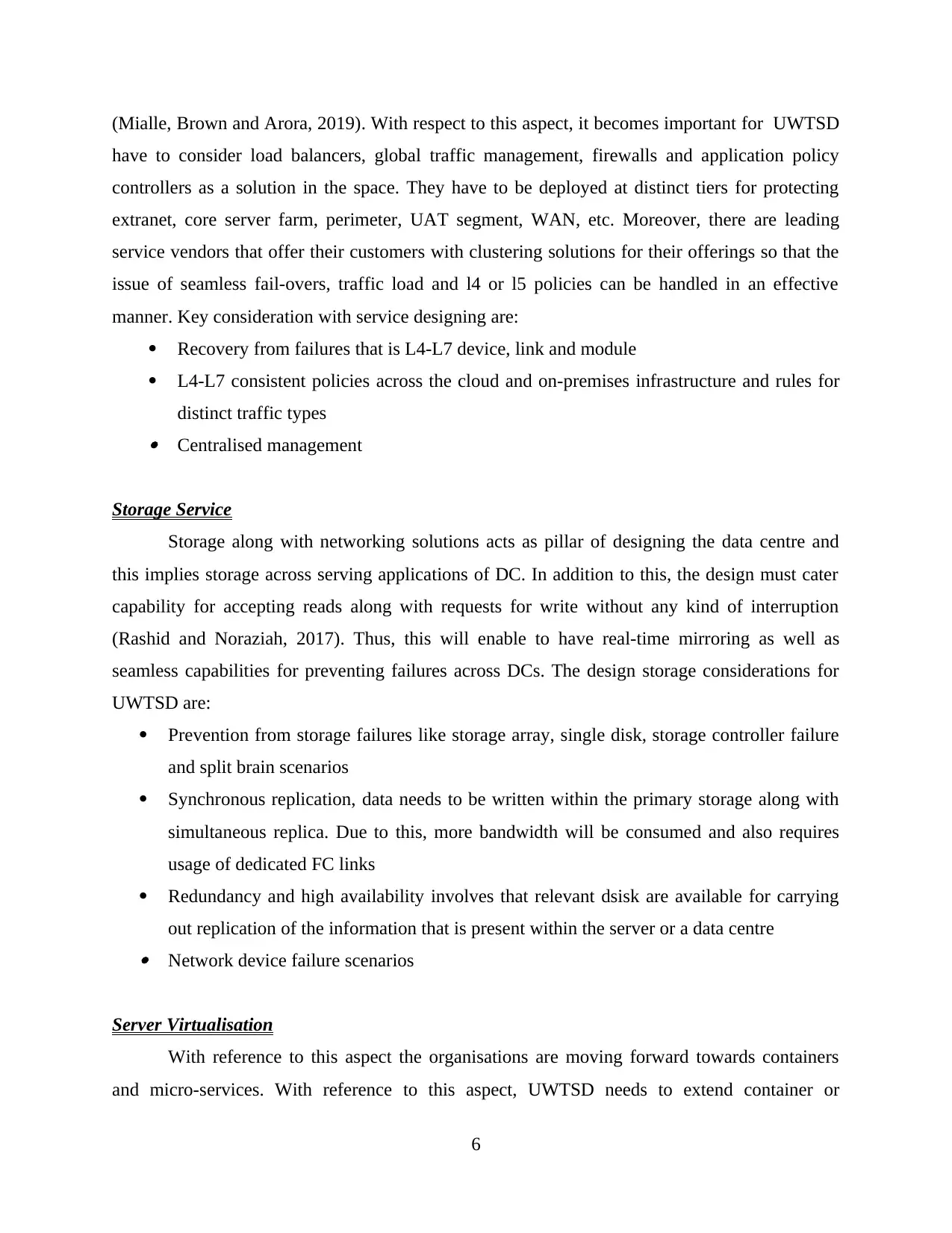
(Mialle, Brown and Arora, 2019). With respect to this aspect, it becomes important for UWTSD
have to consider load balancers, global traffic management, firewalls and application policy
controllers as a solution in the space. They have to be deployed at distinct tiers for protecting
extranet, core server farm, perimeter, UAT segment, WAN, etc. Moreover, there are leading
service vendors that offer their customers with clustering solutions for their offerings so that the
issue of seamless fail-overs, traffic load and l4 or l5 policies can be handled in an effective
manner. Key consideration with service designing are:
Recovery from failures that is L4-L7 device, link and module
L4-L7 consistent policies across the cloud and on-premises infrastructure and rules for
distinct traffic types Centralised management
Storage Service
Storage along with networking solutions acts as pillar of designing the data centre and
this implies storage across serving applications of DC. In addition to this, the design must cater
capability for accepting reads along with requests for write without any kind of interruption
(Rashid and Noraziah, 2017). Thus, this will enable to have real-time mirroring as well as
seamless capabilities for preventing failures across DCs. The design storage considerations for
UWTSD are:
Prevention from storage failures like storage array, single disk, storage controller failure
and split brain scenarios
Synchronous replication, data needs to be written within the primary storage along with
simultaneous replica. Due to this, more bandwidth will be consumed and also requires
usage of dedicated FC links
Redundancy and high availability involves that relevant dsisk are available for carrying
out replication of the information that is present within the server or a data centre Network device failure scenarios
Server Virtualisation
With reference to this aspect the organisations are moving forward towards containers
and micro-services. With reference to this aspect, UWTSD needs to extend container or
6
have to consider load balancers, global traffic management, firewalls and application policy
controllers as a solution in the space. They have to be deployed at distinct tiers for protecting
extranet, core server farm, perimeter, UAT segment, WAN, etc. Moreover, there are leading
service vendors that offer their customers with clustering solutions for their offerings so that the
issue of seamless fail-overs, traffic load and l4 or l5 policies can be handled in an effective
manner. Key consideration with service designing are:
Recovery from failures that is L4-L7 device, link and module
L4-L7 consistent policies across the cloud and on-premises infrastructure and rules for
distinct traffic types Centralised management
Storage Service
Storage along with networking solutions acts as pillar of designing the data centre and
this implies storage across serving applications of DC. In addition to this, the design must cater
capability for accepting reads along with requests for write without any kind of interruption
(Rashid and Noraziah, 2017). Thus, this will enable to have real-time mirroring as well as
seamless capabilities for preventing failures across DCs. The design storage considerations for
UWTSD are:
Prevention from storage failures like storage array, single disk, storage controller failure
and split brain scenarios
Synchronous replication, data needs to be written within the primary storage along with
simultaneous replica. Due to this, more bandwidth will be consumed and also requires
usage of dedicated FC links
Redundancy and high availability involves that relevant dsisk are available for carrying
out replication of the information that is present within the server or a data centre Network device failure scenarios
Server Virtualisation
With reference to this aspect the organisations are moving forward towards containers
and micro-services. With reference to this aspect, UWTSD needs to extend container or
6
Paraphrase This Document
Need a fresh take? Get an instant paraphrase of this document with our AI Paraphraser
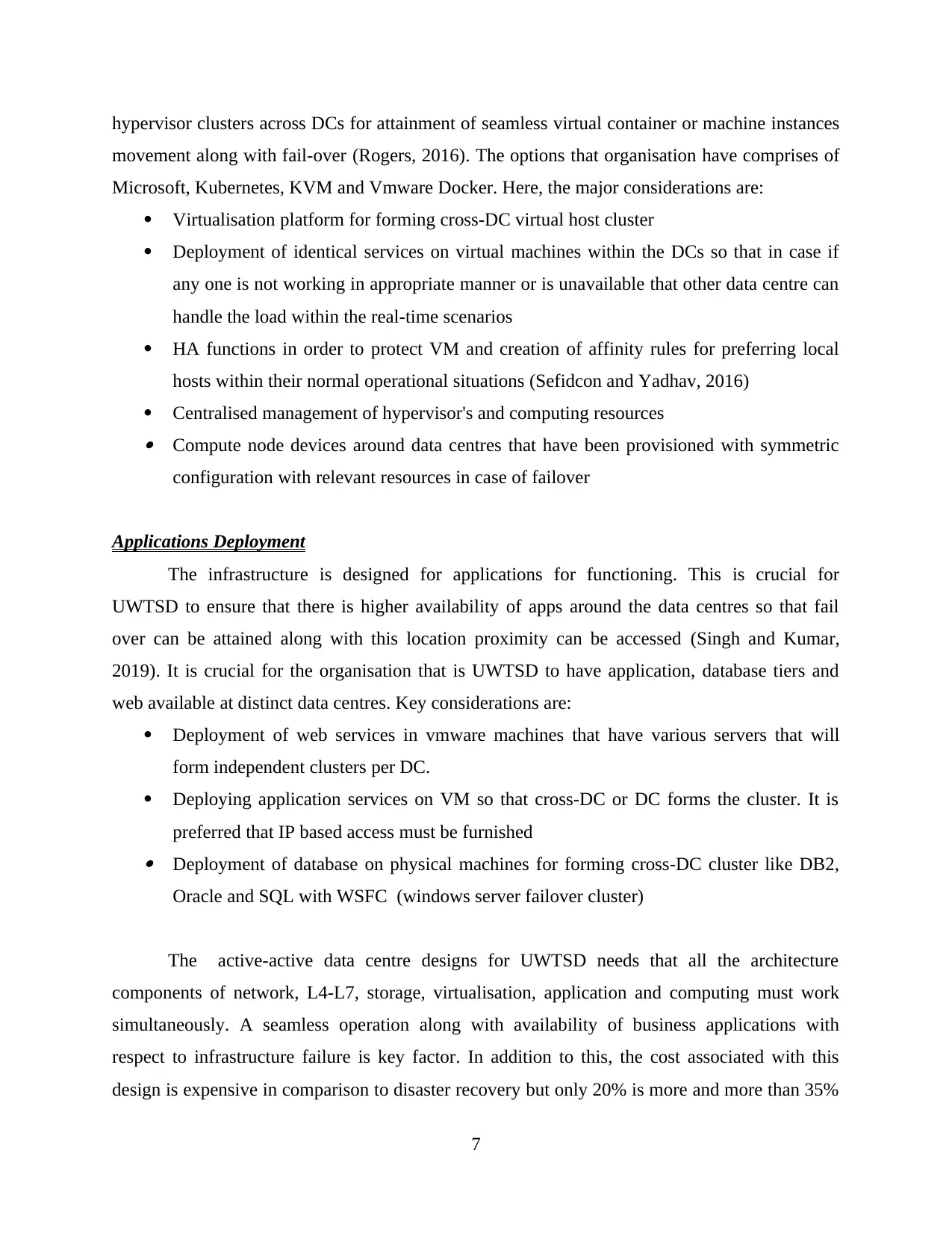
hypervisor clusters across DCs for attainment of seamless virtual container or machine instances
movement along with fail-over (Rogers, 2016). The options that organisation have comprises of
Microsoft, Kubernetes, KVM and Vmware Docker. Here, the major considerations are:
Virtualisation platform for forming cross-DC virtual host cluster
Deployment of identical services on virtual machines within the DCs so that in case if
any one is not working in appropriate manner or is unavailable that other data centre can
handle the load within the real-time scenarios
HA functions in order to protect VM and creation of affinity rules for preferring local
hosts within their normal operational situations (Sefidcon and Yadhav, 2016)
Centralised management of hypervisor's and computing resources Compute node devices around data centres that have been provisioned with symmetric
configuration with relevant resources in case of failover
Applications Deployment
The infrastructure is designed for applications for functioning. This is crucial for
UWTSD to ensure that there is higher availability of apps around the data centres so that fail
over can be attained along with this location proximity can be accessed (Singh and Kumar,
2019). It is crucial for the organisation that is UWTSD to have application, database tiers and
web available at distinct data centres. Key considerations are:
Deployment of web services in vmware machines that have various servers that will
form independent clusters per DC.
Deploying application services on VM so that cross-DC or DC forms the cluster. It is
preferred that IP based access must be furnished Deployment of database on physical machines for forming cross-DC cluster like DB2,
Oracle and SQL with WSFC (windows server failover cluster)
The active-active data centre designs for UWTSD needs that all the architecture
components of network, L4-L7, storage, virtualisation, application and computing must work
simultaneously. A seamless operation along with availability of business applications with
respect to infrastructure failure is key factor. In addition to this, the cost associated with this
design is expensive in comparison to disaster recovery but only 20% is more and more than 35%
7
movement along with fail-over (Rogers, 2016). The options that organisation have comprises of
Microsoft, Kubernetes, KVM and Vmware Docker. Here, the major considerations are:
Virtualisation platform for forming cross-DC virtual host cluster
Deployment of identical services on virtual machines within the DCs so that in case if
any one is not working in appropriate manner or is unavailable that other data centre can
handle the load within the real-time scenarios
HA functions in order to protect VM and creation of affinity rules for preferring local
hosts within their normal operational situations (Sefidcon and Yadhav, 2016)
Centralised management of hypervisor's and computing resources Compute node devices around data centres that have been provisioned with symmetric
configuration with relevant resources in case of failover
Applications Deployment
The infrastructure is designed for applications for functioning. This is crucial for
UWTSD to ensure that there is higher availability of apps around the data centres so that fail
over can be attained along with this location proximity can be accessed (Singh and Kumar,
2019). It is crucial for the organisation that is UWTSD to have application, database tiers and
web available at distinct data centres. Key considerations are:
Deployment of web services in vmware machines that have various servers that will
form independent clusters per DC.
Deploying application services on VM so that cross-DC or DC forms the cluster. It is
preferred that IP based access must be furnished Deployment of database on physical machines for forming cross-DC cluster like DB2,
Oracle and SQL with WSFC (windows server failover cluster)
The active-active data centre designs for UWTSD needs that all the architecture
components of network, L4-L7, storage, virtualisation, application and computing must work
simultaneously. A seamless operation along with availability of business applications with
respect to infrastructure failure is key factor. In addition to this, the cost associated with this
design is expensive in comparison to disaster recovery but only 20% is more and more than 35%
7
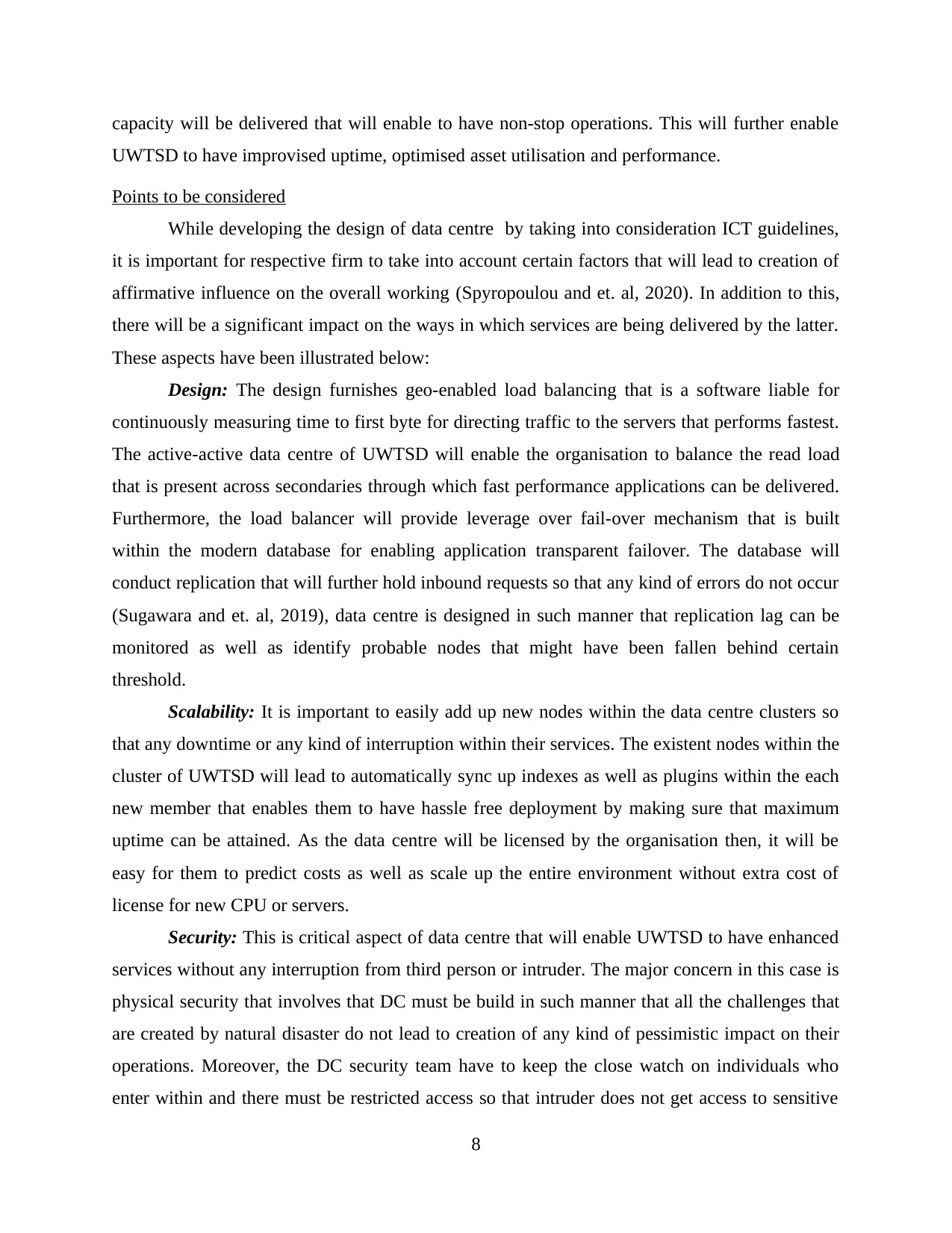
capacity will be delivered that will enable to have non-stop operations. This will further enable
UWTSD to have improvised uptime, optimised asset utilisation and performance.
Points to be considered
While developing the design of data centre by taking into consideration ICT guidelines,
it is important for respective firm to take into account certain factors that will lead to creation of
affirmative influence on the overall working (Spyropoulou and et. al, 2020). In addition to this,
there will be a significant impact on the ways in which services are being delivered by the latter.
These aspects have been illustrated below:
Design: The design furnishes geo-enabled load balancing that is a software liable for
continuously measuring time to first byte for directing traffic to the servers that performs fastest.
The active-active data centre of UWTSD will enable the organisation to balance the read load
that is present across secondaries through which fast performance applications can be delivered.
Furthermore, the load balancer will provide leverage over fail-over mechanism that is built
within the modern database for enabling application transparent failover. The database will
conduct replication that will further hold inbound requests so that any kind of errors do not occur
(Sugawara and et. al, 2019), data centre is designed in such manner that replication lag can be
monitored as well as identify probable nodes that might have been fallen behind certain
threshold.
Scalability: It is important to easily add up new nodes within the data centre clusters so
that any downtime or any kind of interruption within their services. The existent nodes within the
cluster of UWTSD will lead to automatically sync up indexes as well as plugins within the each
new member that enables them to have hassle free deployment by making sure that maximum
uptime can be attained. As the data centre will be licensed by the organisation then, it will be
easy for them to predict costs as well as scale up the entire environment without extra cost of
license for new CPU or servers.
Security: This is critical aspect of data centre that will enable UWTSD to have enhanced
services without any interruption from third person or intruder. The major concern in this case is
physical security that involves that DC must be build in such manner that all the challenges that
are created by natural disaster do not lead to creation of any kind of pessimistic impact on their
operations. Moreover, the DC security team have to keep the close watch on individuals who
enter within and there must be restricted access so that intruder does not get access to sensitive
8
UWTSD to have improvised uptime, optimised asset utilisation and performance.
Points to be considered
While developing the design of data centre by taking into consideration ICT guidelines,
it is important for respective firm to take into account certain factors that will lead to creation of
affirmative influence on the overall working (Spyropoulou and et. al, 2020). In addition to this,
there will be a significant impact on the ways in which services are being delivered by the latter.
These aspects have been illustrated below:
Design: The design furnishes geo-enabled load balancing that is a software liable for
continuously measuring time to first byte for directing traffic to the servers that performs fastest.
The active-active data centre of UWTSD will enable the organisation to balance the read load
that is present across secondaries through which fast performance applications can be delivered.
Furthermore, the load balancer will provide leverage over fail-over mechanism that is built
within the modern database for enabling application transparent failover. The database will
conduct replication that will further hold inbound requests so that any kind of errors do not occur
(Sugawara and et. al, 2019), data centre is designed in such manner that replication lag can be
monitored as well as identify probable nodes that might have been fallen behind certain
threshold.
Scalability: It is important to easily add up new nodes within the data centre clusters so
that any downtime or any kind of interruption within their services. The existent nodes within the
cluster of UWTSD will lead to automatically sync up indexes as well as plugins within the each
new member that enables them to have hassle free deployment by making sure that maximum
uptime can be attained. As the data centre will be licensed by the organisation then, it will be
easy for them to predict costs as well as scale up the entire environment without extra cost of
license for new CPU or servers.
Security: This is critical aspect of data centre that will enable UWTSD to have enhanced
services without any interruption from third person or intruder. The major concern in this case is
physical security that involves that DC must be build in such manner that all the challenges that
are created by natural disaster do not lead to creation of any kind of pessimistic impact on their
operations. Moreover, the DC security team have to keep the close watch on individuals who
enter within and there must be restricted access so that intruder does not get access to sensitive
8
⊘ This is a preview!⊘
Do you want full access?
Subscribe today to unlock all pages.

Trusted by 1+ million students worldwide
1 out of 18
Related Documents
Your All-in-One AI-Powered Toolkit for Academic Success.
+13062052269
info@desklib.com
Available 24*7 on WhatsApp / Email
![[object Object]](/_next/static/media/star-bottom.7253800d.svg)
Unlock your academic potential
Copyright © 2020–2025 A2Z Services. All Rights Reserved. Developed and managed by ZUCOL.





